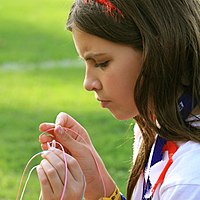
Photo from wikipedia
Previous research has shown that visual working memory (VWM) can be modulated by space-based or feature-based attentional selection. However, it remains unclear how the two modes of attention operate jointly… Click to show full abstract
Previous research has shown that visual working memory (VWM) can be modulated by space-based or feature-based attentional selection. However, it remains unclear how the two modes of attention operate jointly to affect VWM, and in particular, if involuntary feature-based attention plays a role in VWM. In this study, a pre-cued change detection paradigm was employed to investigate the concurrent effects of space- and feature-based attention on VWM. Space-based attention was manipulated by informative spatial cueing and by varying the proximity between the test item and the cued (fixated) memory item, while feature-based attention was induced in an involuntary manner by having the test item to share the same color or shape with the cued item on a fraction of trials. The results showed that: (1) the memory performance for the cued items was always better than the uncued items, suggesting a beneficial effect of voluntary spatial attention; (2) with a brief duration of the memory array (250 ms), cue-test proximity benefited VWM in the shape judgment task but not in the color judgment task, whereas with a longer duration (1200 ms), no proximity effect was found for either task; (3) VWM was improved for the same-colored items regardless of the task and duration; (4) VWM was improved for the same-shaped items only in the shape judgment task with the longer duration of the memory array. A discrimination task further showed that the proximity effect associated with VWM reflects a perceptual bottleneck in memory encoding for shape but not for color with a brief display. Our results suggest that involuntary feature-based attention could be triggered by spatial cueing to modulate VWM; involuntary color-based attention facilitates VWM independently of task, whereas shape-based facilitation is task–dependent, i.e., confined only to the shape judgment task, presumably reflecting different attention-guiding potencies of the two features.
Journal Title: Psychological Research
Year Published: 2019
Link to full text (if available)
Share on Social Media: Sign Up to like & get
recommendations!